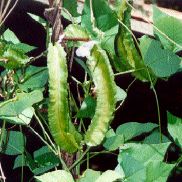Psophocarpus tetragonolobus
Winged bean, Goa bean, Four angled bean, Frijol alata
Tropical
Introduction
The winged bean is a strong growing, twining perennial legume with large beautiful pale blue flowers. The plant is thought to have originated along the east coast of Africa, although the center of diversity has now shifted to the islands of the South Pacific, and especially to Papua New Guinea. Used for leafy green potherbs, fresh pods, dried beans, edible tubers, animal fodder and forage, green manure, and cover crops; winged beans are the ultimate multi-purpose crop. They are a climbing plant well suited to incorporation into agroforestery or multi-story farming systems. Though it has many advantages, winged beans are currently a food crop of commercial value only in the Pacific and Southeast Asia.
To some extent the plant has been a victim of its own potential. During the 70's some development groups over promoted winged beans as an all-purpose wonder crop that could end hunger, in much the way leucaena was promoted as the answer to deforestation. Exaggerated or misleading claims were made. For example, maximum yield figures were given for leaves, fruit, and tubers without pointing out that increasing the yield of one edible part of the plant was generally at the expense of the others and that it was impossible to get anything near the maximum yield for all the edible parts from one plant. Often varieties were planted that were inappropriate for the region because of specific day length requirements for blooming. As a result many groups were profoundly disappointed with brief experiments planting winged beans. Despite these setbacks, winged beans are the real thing botanically. They are well worth the renewed effort that will be needed to learn locally practical ways to utilize what they have to offer.
Pros
- The ultimate multi-purpose crop for small farmers and gardeners in the tropics
- Tasty, mild flavored greens
- Fresh leaves are 5-7% protein which is exceptionally good for tender leafy greens
- Not only are winged bean leaves high in protein but the quality of that protein is superior to that in most leaves.
- Strong nitrogen fixing legume with unusual number of nodules
- Winged bean leaves can be extraordinarily productive. According to Duke, 1981; and Oomen and Grubben 1977, winged bean leaves can produce about 8,000 kg/ha in 60 days or less. This comes to 135 kg/ha per day. This comes to about 63,500 calories; 6.75 kg of protein; 108 grams of calcium; 2.7 grams of iron; 4.1 grams of b-carotene; and 39,150 mg of vitamin C per hectare per day.
- Tolerates heat
- Tolerates acid soil
- Apparently can utilize inexpensive readily available cowpea inoculant to begin nodulation when introduced to new areas
Cons
- Very susceptible to waterlogging
- Very susceptible to frost and cold weather
- Seeds are difficult to germinate. They should be scratched or soaked in hot water before planting.
- Most varieties have photoperiod sensitivities (they bloom only with specific day lengths) that limit the plant's success in many locations.
- Needs good drainage
- Needs lots of water; 1500 mm (c. 58") for good growth; 2500 mm (95") or more for top production
- The 'wings' on fresh winged beans are very delicate which makes them more difficult to handle and to ship than other fresh bean variety.
Notes
- Blue flowers sometimes used to color rice and pastries for special occasions
- Although winged beans are strong nitrogen fixers, much of the nitrogen fixed from the air doesn't become available until the next crop is planted. As a result if you are growing winged beans primarily for the leaves it is useful to add an external source of nitrogen to the soil.
- Yields of fresh pods are normally between 10-15 tons per hectare, though yields as high as 40 tons have been reported.
- Tubers are 8-10% protein and are the generally preferred winged bean product in much of the Pacific. Tuber yields generally are between 5-10 tons per hectare.
- Though a perennial vine, it is often grown as an annual
- Grows well from sea level to 2000 meters
- Typically planted 2.5 -7.5 cm deep about 10 cm apart for foliage, at beginning of rainy season
- Trellised plants produce twice the seed of unstaked plants.
- Picking flowers increases tuber yield
Seeds
ECHO (17391 Durrance Rd. North Fort Myers, Fl 33917 USA e-mail: echo@echonet.org ) tries to carry 4 varieties of winged bean. These include an unusual day-neutral variety. Most winged beans only bloom during short days when the temperature is too cold for good growth or even survival in many locations. The day neutral variety potentially extends the growing range of winged beans further from the hot tropics. Other companies that carry winged bean seed include: Banana Tree (USA); KEO Entities (USA); B &T Associates (England); Sutton and Sons, (India); Phoenix Seeds (Tasmania); Inland and Foreign Trading Co., Ltd. (Singapore); .Tokita Seed Co., Ltd. (Japan).
Related Plants with Edible Leaves
About 185 species of related leguminous plants produce leaves that are eaten to some extent by humans.
